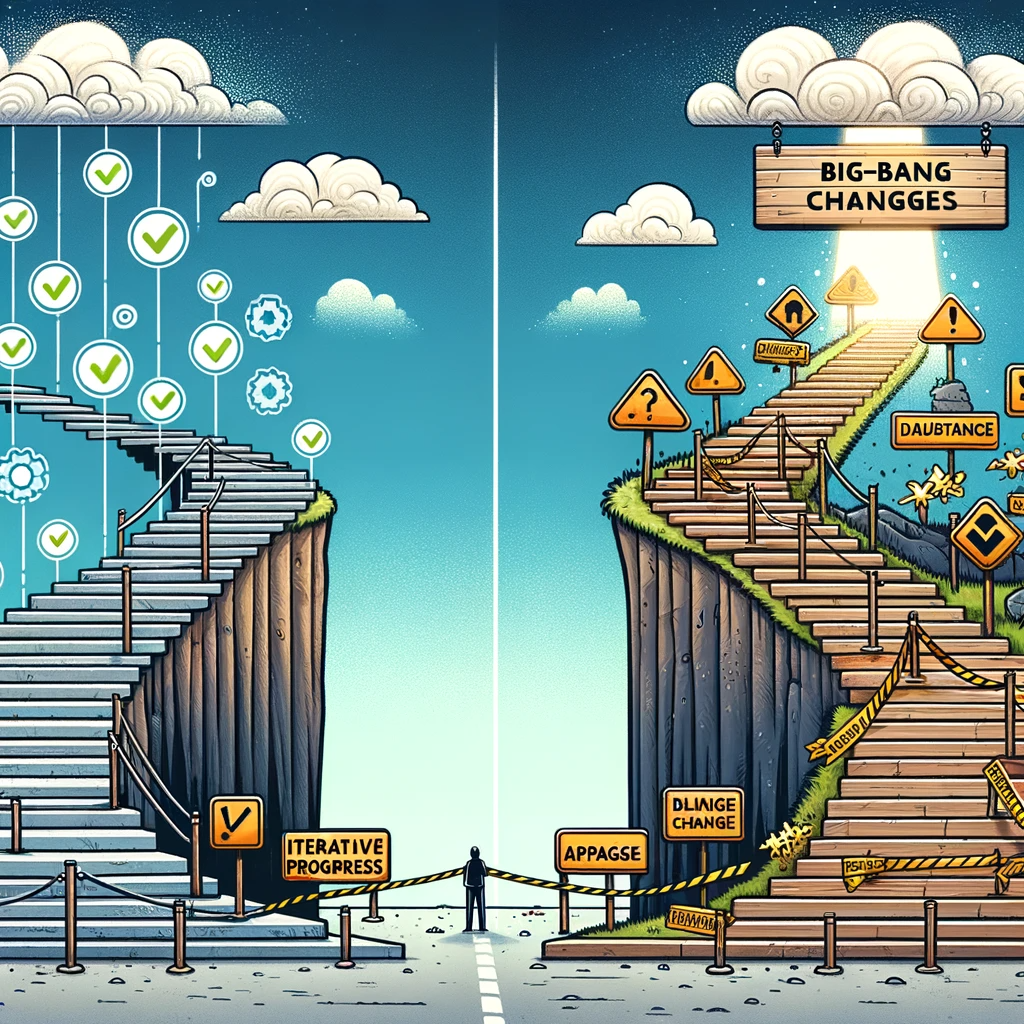
In the world of technology, when dealing with change, two predominant approaches emerge: iterative progress and big-bang changes. While each has its context of applicability, a compelling case can be made for the superiority of iterative progress in most scenarios.
Understanding the Approaches
Iterative Progress is characterized by gradual, continuous improvements or developments in small, manageable phases. This approach allows for frequent assessments, adjustments, and refinements based on feedback and testing at each stage.
Big-bang changes, on the other hand, involve a comprehensive and immediate shift from an old system or process to a new one in a single phase. This approach often seems appealing due to its promise of rapid transformation but comes with significant risks.
Benefits of Iterative Progress
This methodology, characterized by its emphasis on small, manageable increments, allows for constant evaluation and refinement. By breaking down large projects or changes into more digestible pieces, iterative progress offers numerous benefits, including enhanced flexibility, risk mitigation, and increased stakeholder engagement.
Flexibility and Adaptability
Iterative progress thrives on feedback. By implementing changes in small increments, there’s a constant opportunity to adapt and refine based on real-world use and feedback. This adaptability is crucial in today’s fast-paced environment where user needs and market conditions can shift rapidly.
Risk Mitigation
Small, iterative changes significantly reduce risk. When changes are introduced gradually, it’s easier to isolate and rectify issues without affecting the entire system. This containment of risk is particularly vital in complex projects where a single failure can have widespread repercussions.
Enhanced Stakeholder Engagement
Iterative methods promote continuous involvement from stakeholders, including clients, end-users, and team members. This ongoing engagement ensures that the project remains aligned with user needs and expectations, fostering a sense of ownership and satisfaction among all parties involved.
Cost Efficiency
By addressing issues and making adjustments in real-time, iterative progress can be more cost-effective. It prevents the sunk cost fallacy of continuing to invest in a flawed big-bang project simply because of the resources already committed.
Drawbacks of Big-Bang Changes
This approach, while appealing for its promise of rapid overhaul and immediate results, often comes with significant pitfalls. By focusing on big-bang changes we increase the risk of failure, make resistance to change among stakeholders higher, increase the potential for cost overruns, and reduce the possibility of flexibility.
High Risk of Failure
The all-or-nothing nature of big-bang changes means any failure can be catastrophic. The inability to test components in a live environment before full deployment increases the likelihood of unforeseen problems.
Resistance to Change
Big-bang approaches can lead to significant resistance among users and stakeholders. The sudden shift can be overwhelming, leading to a lack of buy-in, which is critical for the success of any change initiative.
Cost Overruns
Without the ability to make incremental adjustments, big-bang projects often face cost overruns. Once a project is underway, any changes or fixes become exponentially more challenging and expensive to implement.
Lack of Flexibility
Once set in motion, big-bang changes offer little room for adaptation. If external conditions change or new information comes to light, it’s difficult to pivot without incurring substantial additional costs and delays.
Making the Case for Iterative Progress
While there are scenarios where big-bang changes might be necessary or beneficial, such as in cases of outdated systems posing immediate risks, the advantages of iterative progress are compelling. The flexibility, risk mitigation, stakeholder engagement, and cost efficiency it offers make it a superior choice for most projects.
Adopting an iterative approach fosters a culture of continuous improvement, learning, and adaptation. It aligns with the agile mindset of responding to change by following a fixed plan, proving to be more resilient and effective in the face of uncertainty.
While both iterative progress and big-bang changes have their places, the evidence leans heavily in favor of iterative progress for sustainable, risk-managed, and adaptive change management. By embracing this approach, organizations can navigate the complexities of change more smoothly, ensuring long-term success and resilience.